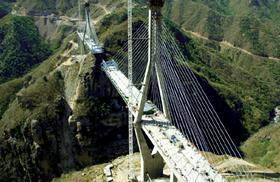
Nogales, in Arizona, has been the traditional gateway for imports of Mexican produce to the US and Canada ever since the Latin American country became a major off-season source during the first half of the 20th century. Ports of entry in the lower Rio Grande Valley of Texas have lagged well behind Nogales in terms of volumes, with Nogales benefitting from one of Mexico’s most modern highways, which connects the major winter growing areas about a day’s travel away.
Nogales’ dominance may soon be a thing of the past, however, due to modernisation of Mexican Federal Highway 40, which runs between the Pacific Coast port of Mazatlan and Reynosa on the US-Texas border.
The key component in the Highway 40 upgrade was the recent construction of the Baluarte Bridge in the Sierra Madre mountain range, which at 402m is the highest in the Western Hemisphere. A Texas A&M University study in 2013 noted that these improvements had shaved off at least six hours of trucking time between west Mexico and the Texas border, as well as reducing transportation costs by as much as US$1,500 delivering to eastern markets. According to the study, imports of fresh produce from Mexico through South Texas have outpaced those of Nogales since 2010, and it predicts that the gap will widen to more than 100,000 truckloads by the end of the decade.
Nogales importers are hardly conceding their hard-earned business to South Texas, however. The Fresh Produce Association of the Americas (FPAA), which represents the interests of some 120 US companies tied to the Nogales industry, announced recently that tonnage of Mexican produce passing through its port increased by 17 per cent during the winter importing season, whereas volume through South Texas was flat.
The FPAA cites upgrades to Nogales’ Mariposa port of entry, which have reduced truck waiting time, as the primary reason behind the increased tonnage.
Nevertheless, a more direct route to the major metropolitan regions of the eastern US and Canada will be difficult for the buying side of the industry to ignore if the improvements to Mexico Highway 40 prove to be all they are expected to be. In the longer run, North American consumers should be the beneficiaries of these infrastructure upgrades serving the two major gateways, in the form of fresher winter fruits and vegetables.



